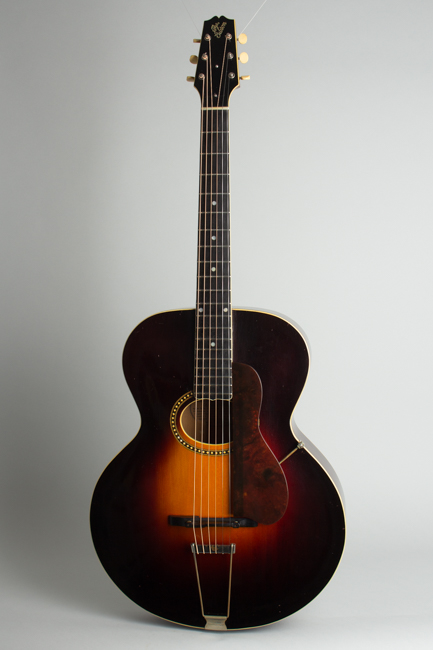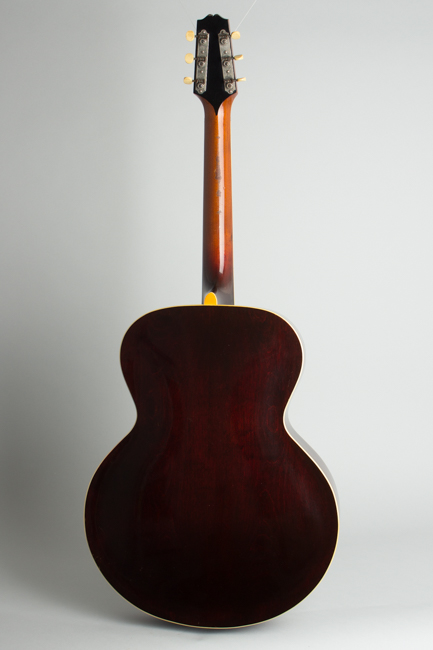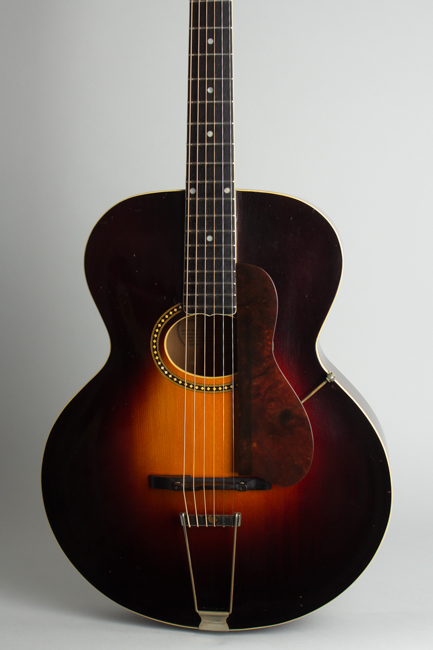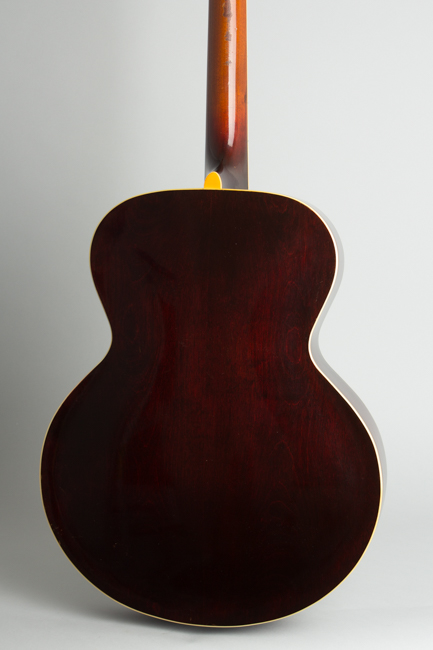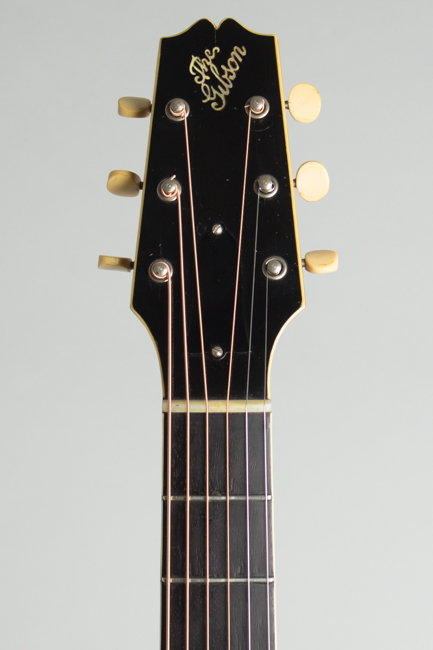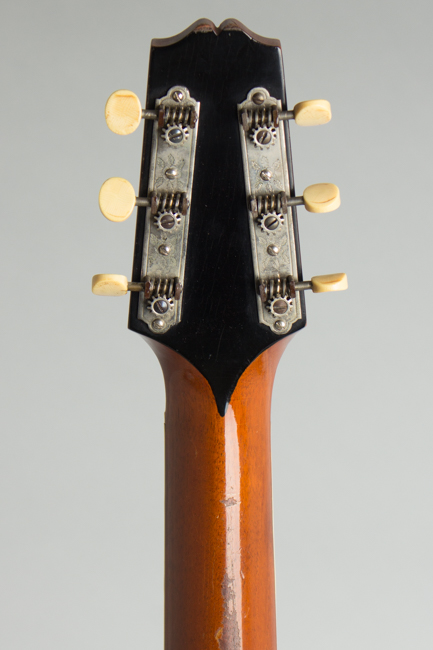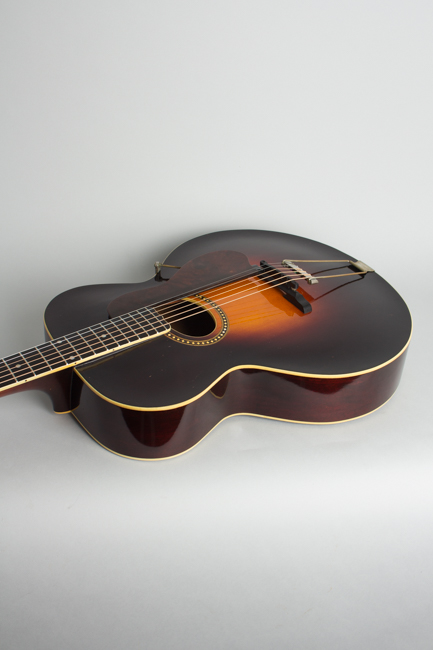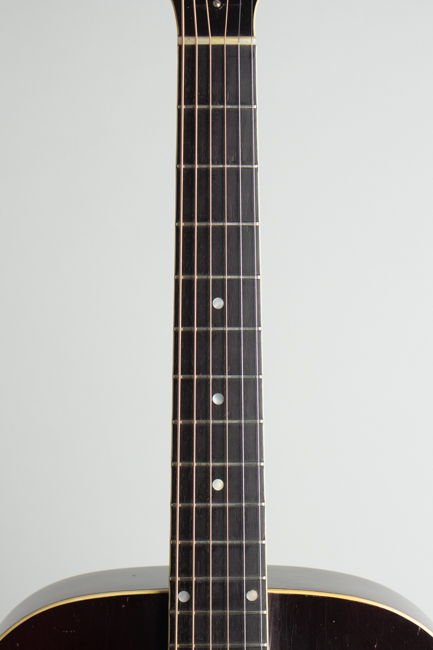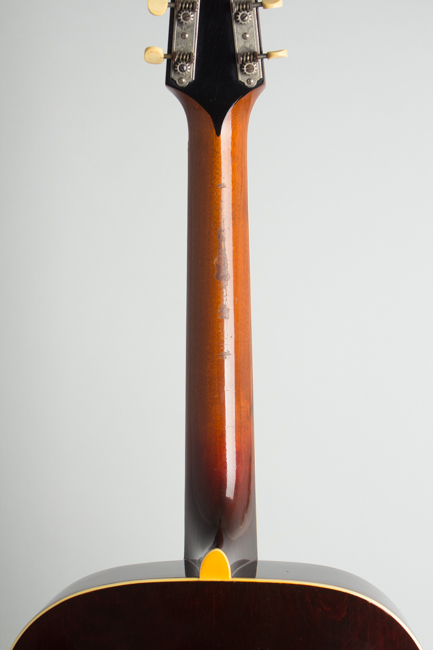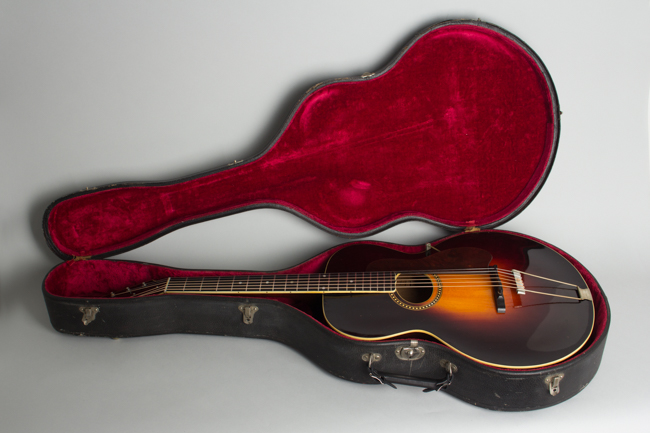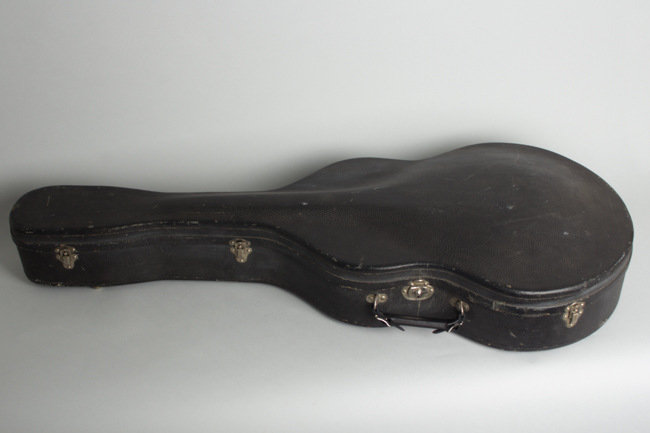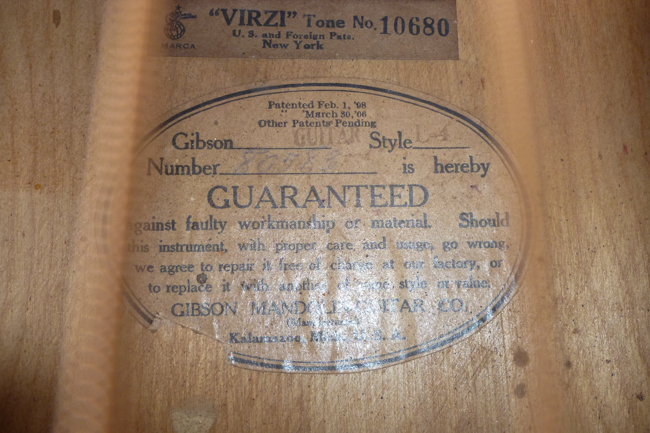Gibson L-4 with Virzi Tone Producer Arch Top Acoustic Guitar (1925)
This item has been sold.
Item # 9328
Prices subject to change without notice.
Gibson L-4 with Virzi Tone Producer Model Arch Top Acoustic Guitar (1925), made in Kalamazoo, Michigan, serial # 80583, red sunburst top, dark stained back and sides finish, birch back and sides, spruce top; mahogany neck with ebony fingergoard, original black hard shell case.
This is a very interesting, quite rare, and mostly just way cool carved-top guitar -- a "snakehead" L-4 from the just-post "Lloyd Loar Era" at Gibson. It is comparatively little used and easily the nicest example from this period we have ever had. It also plays and sounds great with a wonderful vibe. The factory order number indicates it was built in later 1925 just after "Master Loar" left the building, and the serial number suggests was shipped out in early-mid 1926.
Lloyd Loar's tenure as "acoustic engineer" at Gibson has become so mythical that sometimes separating fact from fiction is difficult. Loar primarily concerned himself with mandolins, but Gibson guitars in the mid-20's were also improved, benefitting from the influence of other Gibson employees (especially Thaddeus McHugh and Lewis A. Williams) who engineered many technical improvements. Loar was primarily concerned with "voicing" the instruments; the Master Model Style 5 line was his greatest contribution with their violin-style f-hole tops, but all Gibson instruments were refined at the time.
The guitar is generally similar to earlier L-4's but with a number of notable changes. The sunburst finish is early Gibson lacquer (they transitioned from varnish right around this time) and has a darker, richer look than earlier examples. It also features a new slimmer soft "V" profile neck, much more comfortable than the earlier wide, super chunky deep "V" design. It also benefits from several "Modern" Gibson features introduced in the 1920's including the adjustable ebony bridge, adjustable truss rod in the neck and solid tailpiece bar in place of the earlier pin variant. The sharply slanted "The Gibson" logo sits on its single-bound "snakehead" peghead above the then-new truss rod cover. This slimmer peghead is a rare feature on the l-4 seen only in this particular time; both earlier and later examples have the wider traditional Gibson shape. The wide oval sound hole is still bound bordered with an elaborate diamond marquetry motif as before.
This instrument includes one of Loar's most oddball obsessions, the "Virzi Tone Producer", mounted under the top. The Virzi Tone Producer was marketed by Virzi Bros. violin company in New York. This flat thin spruce disc was mounted beneath the bridge and supposed to boost vibrations in the sound chamber, supposedly enhancing harmonic partials. Championed by Loar, it was offered by Gibson as an optional extra cost feature at the time. The Virzi was mostly seen in the expensive Gibson Master Model mandolins, and it is very uncommon to find one in an L-4.
While the $150 L-4 was not Gibson's top-line guitar in 1925 only the Style U Harp Guitar and new-for-1924 Master Model L-5 exceeded it in price. With a large 16" wide body and carved top and back, it was unlike any other guitar available at the time. Martins of this era were just transitioning from gut-string instruments, and the L-4's combination of steel-string power and punch was unique. Many early jazz greats used similar L-4s extensively into the late 1920s, including Eddie Lang and Freddy Guy with Duke Ellington's Orchestra. Besides being something of a rarity, this Loar-style L-4 is a powerful-sounding guitar with a big open tone compared to earlier Gibsons.
Overall length is 39 1/8 in. (99.4 cm.), 16 in. (40.6 cm.) wide at lower bout, and 3 7/16 in. (8.7 cm.) in depth at side, taken at the end block. Scale length is 25 in. (635 mm.). Width of nut is 1 11/16 in. (43 mm.).
This guitar is in exceptionally fine original condition for the era, and overall shows VERY little wear. The finish is still shiny with some light scuffing and small dings, with virtually no checking. The only really notable wear to the wood is on the back of the neck where there are some capo Marks through the finish, the deepest feeling being behind the third fret. The guitar has been refretted with somewhat more modern crown wire but still retains a vintage feel. The original "turnover" bridge saddle has been undercut somewhat at the ends to allow a lower adjustment, but this is not conspicuous. This is a stunning period piece and a great guitar for any era, still housed in the original Gibson HSC that also fits an L-5. Excellent + Condition.
This is a very interesting, quite rare, and mostly just way cool carved-top guitar -- a "snakehead" L-4 from the just-post "Lloyd Loar Era" at Gibson. It is comparatively little used and easily the nicest example from this period we have ever had. It also plays and sounds great with a wonderful vibe. The factory order number indicates it was built in later 1925 just after "Master Loar" left the building, and the serial number suggests was shipped out in early-mid 1926.
Lloyd Loar's tenure as "acoustic engineer" at Gibson has become so mythical that sometimes separating fact from fiction is difficult. Loar primarily concerned himself with mandolins, but Gibson guitars in the mid-20's were also improved, benefitting from the influence of other Gibson employees (especially Thaddeus McHugh and Lewis A. Williams) who engineered many technical improvements. Loar was primarily concerned with "voicing" the instruments; the Master Model Style 5 line was his greatest contribution with their violin-style f-hole tops, but all Gibson instruments were refined at the time.
The guitar is generally similar to earlier L-4's but with a number of notable changes. The sunburst finish is early Gibson lacquer (they transitioned from varnish right around this time) and has a darker, richer look than earlier examples. It also features a new slimmer soft "V" profile neck, much more comfortable than the earlier wide, super chunky deep "V" design. It also benefits from several "Modern" Gibson features introduced in the 1920's including the adjustable ebony bridge, adjustable truss rod in the neck and solid tailpiece bar in place of the earlier pin variant. The sharply slanted "The Gibson" logo sits on its single-bound "snakehead" peghead above the then-new truss rod cover. This slimmer peghead is a rare feature on the l-4 seen only in this particular time; both earlier and later examples have the wider traditional Gibson shape. The wide oval sound hole is still bound bordered with an elaborate diamond marquetry motif as before.
This instrument includes one of Loar's most oddball obsessions, the "Virzi Tone Producer", mounted under the top. The Virzi Tone Producer was marketed by Virzi Bros. violin company in New York. This flat thin spruce disc was mounted beneath the bridge and supposed to boost vibrations in the sound chamber, supposedly enhancing harmonic partials. Championed by Loar, it was offered by Gibson as an optional extra cost feature at the time. The Virzi was mostly seen in the expensive Gibson Master Model mandolins, and it is very uncommon to find one in an L-4.
While the $150 L-4 was not Gibson's top-line guitar in 1925 only the Style U Harp Guitar and new-for-1924 Master Model L-5 exceeded it in price. With a large 16" wide body and carved top and back, it was unlike any other guitar available at the time. Martins of this era were just transitioning from gut-string instruments, and the L-4's combination of steel-string power and punch was unique. Many early jazz greats used similar L-4s extensively into the late 1920s, including Eddie Lang and Freddy Guy with Duke Ellington's Orchestra. Besides being something of a rarity, this Loar-style L-4 is a powerful-sounding guitar with a big open tone compared to earlier Gibsons.
Overall length is 39 1/8 in. (99.4 cm.), 16 in. (40.6 cm.) wide at lower bout, and 3 7/16 in. (8.7 cm.) in depth at side, taken at the end block. Scale length is 25 in. (635 mm.). Width of nut is 1 11/16 in. (43 mm.).
This guitar is in exceptionally fine original condition for the era, and overall shows VERY little wear. The finish is still shiny with some light scuffing and small dings, with virtually no checking. The only really notable wear to the wood is on the back of the neck where there are some capo Marks through the finish, the deepest feeling being behind the third fret. The guitar has been refretted with somewhat more modern crown wire but still retains a vintage feel. The original "turnover" bridge saddle has been undercut somewhat at the ends to allow a lower adjustment, but this is not conspicuous. This is a stunning period piece and a great guitar for any era, still housed in the original Gibson HSC that also fits an L-5. Excellent + Condition.
